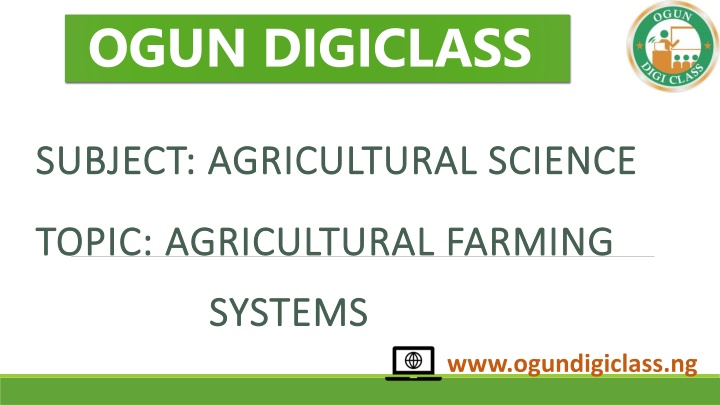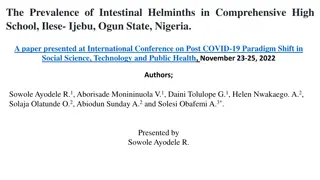OGUN DIGICLASS
Farming has evolved over time from gathering to planting and rearing livestock, leading to various agricultural farming systems. Factors like water, land, climate, and landscape influence these systems. Subsistence production, one such system, focuses on personal and family consumption, utilizing available land and diverse crops. Vertical farming practices ensure food supply in limited land spaces.
Download Presentation

Please find below an Image/Link to download the presentation.
The content on the website is provided AS IS for your information and personal use only. It may not be sold, licensed, or shared on other websites without obtaining consent from the author.If you encounter any issues during the download, it is possible that the publisher has removed the file from their server.
You are allowed to download the files provided on this website for personal or commercial use, subject to the condition that they are used lawfully. All files are the property of their respective owners.
The content on the website is provided AS IS for your information and personal use only. It may not be sold, licensed, or shared on other websites without obtaining consent from the author.
E N D
Presentation Transcript
OGUN DIGICLASS SUBJECT: AGRICULTURAL SCIENCE SUBJECT: AGRICULTURAL SCIENCE TOPIC: TOPIC: AGRICULTURAL FARMING AGRICULTURAL FARMING SYSTEMS SYSTEMS www.ogundigiclass.ng
LEARNING OBJECTIVES LEARNING OBJECTIVES Identify various Agricultural farming systems. Mention factors influencing farming systems. Give at least two features of each farming system. Differentiate between the main agricultural farming systems available.
INTRODUCTION INTRODUCTION Farming is as old as man itself. It began from gathering of fruits (and other edibles), moved to hunting of wild animals, proceeded to planting of wild seeds and rearing of domesticated livestock which brought about the first farming system. Agricultural farming systems are a set of strategies to manage the available resources to achieve economic and sustainable agricultural production
Factors influencing Factors influencing Farming systems. Farming systems. Several factors have influenced the types of farming systems practiced in different parts of the world. These factors include; Available water Land grazing areas arable lands forest climate landscape etc.
TYPES OF FARMING SYSTEMS TYPES OF FARMING SYSTEMS
Subsistence Production Subsistence Production Purpose: Production of crops & livestock for personal and family consumption
Subsistence Production Subsistence Production Land Use: Utilizes land resources available regardless of size, shape, suitability
Subsistence Production Subsistence Production Crops: mixed crops (variety), companion crops and often includes animals.
Subsistence Production Subsistence Production Cropping practices Aimed at providing a continuous supply of food Vertical farming methods employed where land is scarce
Subsistence Production Subsistence Production Labour Use High labour requiremen ts, provided by family, including children
Subsistence Production Subsistence Production Technology Little or no advanced technology use (primitive tools), sometimes animal power use.
Subsistence Production Subsistence Production Fertilizer Use Little or No inorganic fertilizer use depend largely on recycled animal waste or farmyard manure.
Subsistence Subsistence Production Production Agrochemicals Pesticides or herbicides used only if available and/or affordable
Subsistence Subsistence Production Production Harvesting Harvest is by hand and continuous where the growing season allows
Subsistence Subsistence Production Production Storage and Preservation Crude preservation techniques and limited storage capability ambient conditions (barns, kitchen roofs)
Commercial Production Commercial Production Purpose: Produce crops and livestock for sale and profit NNN
Commercial Production Commercial Production Land Use: Requires large, contiguous acreage This Photo by Unknown Author is licensed under CC BY-SA
Commercial Production Commercial Production Crops: Single or few Crops on large scale/ rotational monoculture
Commercial Production Commercial Production Cropping practices Aimed at production efficiency and profitability (scale) Highly mechanized (soil prep, planting, cultivation, harvesting, handling)
Commercial Commercial Production Production Labour Use Minimal hired labour due to automation
Commercial Production Commercial Production Aquaponics Technology modern technology use and research- based methods employed. Greenhouse technology
Commercial Commercial Production Production Fertigation Fertilizer Use Regular and mechanized use of fertilizers
Commercial Production Commercial Production Agrochemical Use Aerial Chemical spray Regular and mechanized use of pesticides and herbicides
Commercial Commercial Production Production Harvesting Harvest is short- term and scheduled to maximize yield and quality
Commercial Commercial Production Production Storage & preservation Modern storage equipments use for short and long-term storage common. Processing for better preservation or value addition.
Summarily, the differences between Subsistence and Commercial farming is shown below
Identify at least five Agricultural farming system and explain any two? EVALUATION EVALUATION Highlight three features each of Subsistence and Commercial Agriculture.
ASSIGNMENT ASSIGNMENT State five differences between commercial agriculture and subsistence agriculture. (WASSCE Theory question)







